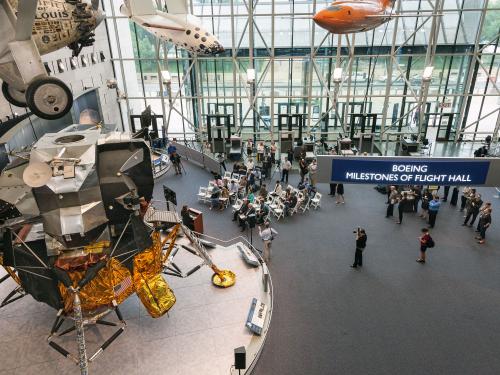
Stories of daring, stories of technological feats, stories of prevailing against the odds ... these are the stories we tell at the National Air and Space Museum. Dive in to the stories below to discover, learn, and be inspired.
Showing 1171 - 1180 of 1761

July 30, 2016
isitors and staff alike are finding Pokémon alongside the Museum’s collection: a Bulbasaur by the Spirit of St. Louis; a Growlithe on the 1903 Wright Flyer; a Chariz … Wait, why are there so many Doduo in the West wing?

July 29, 2016
The Museum is fortunate that among our corps of docents, or guides, are people with direct experience flying or flying in a number of our aircraft. Among those docents are Buz Carpenter and Phil Soucy who know what its like to sit inside one of the world's fastest aircrafts, the Lockheed SR-71 Blackbird.

July 28, 2016
In 1976, the Lockheed SR-71 Blackbird broke the world’s record for sustained altitude in horizontal flight at 25,929 meters (85,069 feet). The same day another SR-71 set an absolute speed record of 3,529.6 kilometers per hour (2,193.2 miles per hour), approximately Mach 3.3. As the fastest jet aircraft in the world, the SR-71 has an impressive collection of records and history of service. The Blackbird’s owes its success to the continuum of aircraft that came before it.

July 27, 2016
The last time Neil Armstrong's gloves and helmet were displayed, in 2012, visitors asked us about “grey spots” on the right glove. We're conducting research and examining historical documentation to find out why.

July 25, 2016
As the National Air and Space Museum’s annual Mars Day! celebration approaches, we look to a recent research trip taken by a Smithsonian Summer Intern to investigate the similarities between some of Earth’s most amazing dunes and those found on the ruddy surface of Mars.

July 24, 2016
Did you know Earhart created a clothing line called “Amelia Fashions” in 1933? Earhart had been interested in flying apparel for women for years. At the beginning of her career, Earhart had to wear aviation suits that were designed for men and poorly fitted for a woman. There was nothing else available.

July 24, 2016
On July 24, 1954, the Naval Research Laboratory (NRL) at Stump Neck, Maryland sent and received the first human voice transmission to be bounced back to Earth from the Moon. Moon bounce, also known as Earth-Moon-Earth (EME) communication, is a technique that sends radio wave transmissions from Earth to the Moon.

July 21, 2016
On July 20, 1969, Neil Armstrong stepped onto the lunar surface, and the U.S. Treasury turned to America’s newest space heroes to fundraise. In 1970, the Advertising Council began one of the Treasury’s longest running Savings Bond promotions, “Take stock in America.” One of the first posters produced for the promotion is a photographic assembly depicting the United States’ conquest of the Moon.

July 21, 2016
The Museum’s Lunar Module LM-2 represents a dilemma, at least for the current generation of Smithsonian curators and conservators. What stages of its history are most important, and how should it to be presented to the public?

July 20, 2016
In partnership with the Smithsonian Digital Program Office (DPO), we all now have access to the most detailed view of the inside and outside of the command module Columbia. Using state-of-the-art 3D scanning and photogrammetry, DPO captured the real artifact in such high detail that every bolt and thread can be seen.